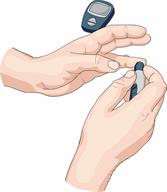Type 2 Diabetes Mellitus, Self-Care, Pediatric
Caring for your child who has type 2 diabetes (
type 2 diabetes mellitus) means keeping your child's blood sugar (
glucose) under control. You can do that with a balance of:
What are the risks?
Having diabetes can put your child at risk for other long-term (chronic) conditions, such as thyroid disease, celiac disease, high cholesterol, heart disease, and kidney disease. Your child's health care provider may prescribe medicines to help prevent complications from diabetes.
How to monitor blood glucose

-
Check your child's blood glucose every day, as often as told by your child's health care provider.
-
Have your child's A1C (hemoglobin A1C) level checked two or more times a year, or as often as told by your child's health care provider.
-
Your child's health care provider will set personalized treatment goals for your child.
How to manage your child's hyperglycemia and hypoglycemia
Hyperglycemia symptoms
High blood glucose is called hyperglycemia. It occurs when blood glucose is too high. Make sure you know the early signs of hyperglycemia, such as:
Hypoglycemia symptoms
Hypoglycemia, also called low blood glucose, occurs with a blood glucose level at or below 70 mg/dL (3.9 mmol/L). Diabetes medicines lower blood glucose levels and increase the risk for hypoglycemia. The risk for hypoglycemia increases during or after exercise, during sleep, during illness, and when skipping meals or not eating for a long time (fasting).
It is important to know the symptoms of hypoglycemia and treat it right away. Your child should always have a 15-gram rapid-acting carbohydrate snack available to treat low blood glucose. Family members and caregivers should also know the symptoms and should understand how to treat hypoglycemia. Symptoms may include:
Hunger.
Anxiety.
Sweating and feeling clammy.
Dizziness or feeling light-headed.
Sleepiness.
Increased heart rate.
Irritability.
Crying more often than usual.
A dramatic change in behavior.
Tingling or numbness around the mouth, lips, or tongue.
Restless sleep.
Severe hypoglycemia is when your child's blood glucose level is at or below 54 mg/dL (3 mmol/L).
Severe hypoglycemia is an emergency. Do not wait to see if the symptoms will go away. Get medical help right away. Call your local emergency services (911 in the U.S.).
If your child has severe hypoglycemia and cannot eat or drink, your child may need glucagon. You will be taught how to check your child's blood glucose and how to give your child glucagon. Ask your child's health care provider if your child needs to have an emergency glucagon kit available at home and at school.
Follow these instructions at home:
Medicines
-
If your child's health care provider has prescribed insulin or other diabetes medicines, have your child take them as he or she has been told by his or her health care provider. This will help to keep your child's blood glucose levels in the healthy range.
-
Do not let your child run out of insulin or other diabetes medicines. Plan ahead so your child always has these available.
-
If your child uses insulin, adjust the dosage based on his or her level of physical activity and what foods he or she eats. Your child's health care provider will tell you how to do this.
-
Give over-the-counter and prescription medicines only as told by your child's health care provider.
Eating and drinking

What your child eats and drinks affects his or her blood glucose and insulin dosage. Encourage healthy food choices. Help your child control his or her diabetes and prevent other health problems by making good choices. A healthy meal plan includes eating lean proteins, complex carbohydrates, fresh fruits and vegetables, low-fat dairy products, and healthy fats.
Make an appointment to see a registered dietitian to help you create an eating plan that is right for your child. Make sure that your child:
Follows instructions from his or her health care provider about eating or drinking restrictions.
Drinks enough fluid to keep his or her urine pale yellow.
Keeps a record of the carbohydrates that he or she eats. You and your child can do this by reading food labels and learning the standard serving sizes of foods.
Follows his or her sick-day plan whenever he or she cannot eat or drink as usual. Make this plan in advance with your child and his or her health care provider.
Activity
- Have your child exercise regularly, as told by your child's health care provider. This may include:
Stretching and doing strength exercises, such as yoga or weight lifting, 2 or more times a week.
Doing 60 minutes of moderate-intensity exercise each day. Moderate-intensity exercise includes brisk walking, running, and certain sports.
- Your child may need more carbohydrates before, during, and after physical activity. It is important for your child to have a rapid-acting carbohydrate snack available before, during, and after exercise. This helps prevent or treat hypoglycemia.
-
If your child plays a sport, tell the coach that your child has diabetes.
-
Talk with your child's health care provider before your child starts a new exercise or activity. Work with your child's health care provider to adjust insulin, medicines, or food intake as needed.
Care for your child's body
-
Keep your child's immunizations up to date.
-
Schedule an eye exam for your child when he or she is age 10 or older and has had diabetes for 3–5 years. After the first exam, your child should have an eye exam every year.
-
Check your child's skin and feet every day for cuts, bruises, redness, blisters, or sores.
-
After your child begins puberty, he or she should have a complete foot exam by a health care provider. After the first exam, your child should have a foot exam every year.
- Have your child:
Brush his or her teeth and gums two times a day.
Floss one or more times a day.
Visit the dentist one or more times every 6 months.
-
Keep in mind that growth spurts and puberty can affect blood glucose levels and the amount of insulin that your child needs.
General instructions
-
Share your child's diabetes management plan with your child's caregivers, including people in your child's school and household.
-
Have your child carry a medical alert card or wear medical alert jewelry.
-
Teach your child to avoid alcohol and tobacco.
-
Keep all follow-up visits. This is important.
Questions to ask your health care provider
For help and guidance and for more information about your child's diabetes, please visit:
Summary
-
Caring for your child who has type 2 diabetes (type 2 diabetes mellitus) means keeping your child's blood sugar (glucose) under control with a balance of nutrition, exercise, and diabetes medicines if needed.
-
Check your child's blood glucose every day, as often as told by your child's health care provider.
-
Share your child's diabetes management plan with your child's caregivers, including people in your child's school and household.
-
It is important that you have an active role in your child's diabetes care.
-
Keep all follow-up visits. This is important.
This information is not intended to replace advice given to you by your health care provider. Make sure you discuss any questions you have with your health care provider.

